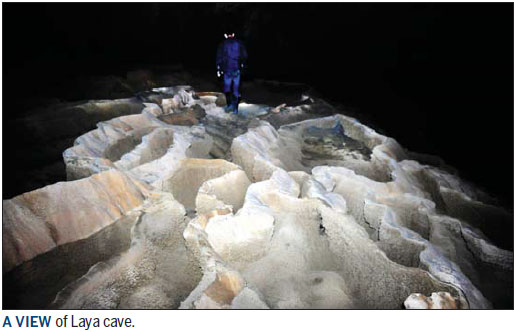What lies beneath

French and Chinese cavers and scientists spend 10 days exploring mysteries of 16.5-kilometer, undocumented system in Southwest China
Southwest China's Guangxi Zhuang autonomous region is known for its picturesque karst landscape, but the expanse beneath the otherworldly topography of limestone towers and forested spires is just as mesmerizing.
The region, with one of the planet's greatest concentrations of undocumented caves, has become a magnet for cavers and scientists from home and abroad. Karst terrain is characterized by caves, sinkholes and underground rivers caused by the excavating effects of underground water on soluble limestone, according to Britannica.com.
| Cavers inside a spacious passage of a big cave in Donglan county, Guangxi Zhuang autonomous region. Photos Provided to China Daily |
During a recent scientific expedition, six French cavers and nine Chinese cavers and scientists explored the karst caves scattered across Guangxi's Donglan county and made a few remarkable discoveries, including a 420-meter-deep sinkhole, traces of an ancient military tunnel and rare plant and animal species.
"We never expected to find such a deep sinkhole, since its entrance is only 100 meters in diameter," says Chen Lixin, a Chinese caver who participated in the expedition.
He says the sinkhole is even deeper, because there is a pool at the bottom, but without diving gear they couldn't plumb its depths.
The explorers announced their achievements on March 4 at a news conference in the county. Jean Bottazzi, a well-known French caver who has lived in China for several years to explore the country's underground kingdom, said they explored 12 caves with a total length of 16.5 kilometers during a 10-day expedition that started on Feb 26.
The sinkhole is much deeper than common sinkholes found in the area, which often are about 250 meters deep, Bottazzi said.
They also measured a tunnel - 1,992 meters long and with a vertical range of up to 108 meters - and recorded traces of military use that need further research by archaeologists.
Many rare plant and animal species living in the underground caves also were noted.
A completely white fish found in an underground river might be the rare Sinocyclocheilus purpureus, a species of ray-finned fish first found in neighboring Yunnan province. Scientists also found several species of white insects.
Donglan has a large variety of geographic features, and many caves have unique ecosystems that need further research, Bottazzi said.
"The cave system is so complicated that is challenging for us to explore."
Contact the writers at chenliang@chinadaily.com.cn



| A member of the exploratory team measures a cave. |
| An insect inside the caves lives its life in the dark. |
| The caves provide a refuge for many creatures, such as this snake. |


(China Daily European Weekly 03/18/2016 page14)
Today's Top News
- Takaichi must stop rubbing salt in wounds, retract Taiwan remarks
- Millions vie for civil service jobs
- Chinese landmark trade corridor handles over 5m TEUs
- China holds first national civil service exam since raising eligibility age cap
- Xi's article on CPC self-reform to be published
- Xi stresses improving long-term mechanisms for cyberspace governance


































